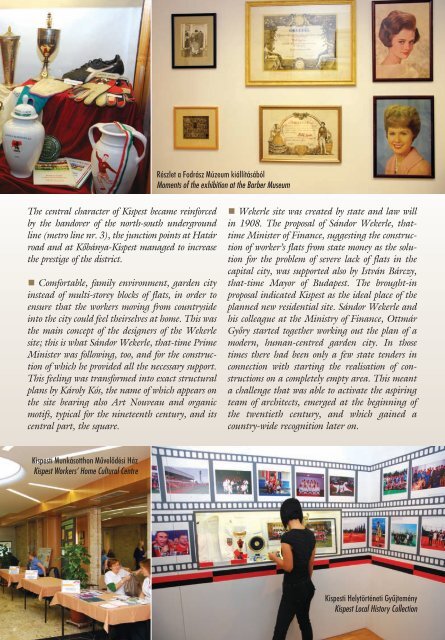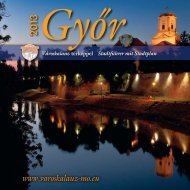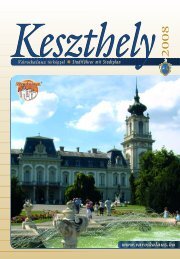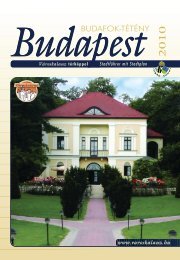2011 KISPEST - Városkalauz
2011 KISPEST - Városkalauz
2011 KISPEST - Városkalauz
You also want an ePaper? Increase the reach of your titles
YUMPU automatically turns print PDFs into web optimized ePapers that Google loves.
The central character of Kispest became reinforced<br />
by the handover of the north-south underground<br />
line (metro line nr. 3), the junction points at Határ<br />
road and at Kôbánya-Kispest managed to increase<br />
the prestige of the district.<br />
� Comfortable, family environment, garden city<br />
instead of multi-storey blocks of flats, in order to<br />
ensure that the workers moving from countryside<br />
into the city could feel theirselves at home. This was<br />
the main concept of the designers of the Wekerle<br />
site; this is what Sándor Wekerle, that-time Prime<br />
Minister was following, too, and for the construction<br />
of which he provided all the necessary support.<br />
This feeling was transformed into exact structural<br />
plans by Károly Kós, the name of which appears on<br />
the site bearing also Art Nouveau and organic<br />
motifs, typical for the nineteenth century, and its<br />
central part, the square.<br />
Kispesti Munkásotthon Mûvelôdési Ház<br />
Kispest Workers’ Home Cultural Centre<br />
Részlet a Fodrász Múzeum kiállításából<br />
Moments of the exhibition at the Barber Museum<br />
� Wekerle site was created by state and law will<br />
in 1908. The proposal of Sándor Wekerle, thattime<br />
Minister of Finance, suggesting the construction<br />
of worker’s flats from state money as the solution<br />
for the problem of severe lack of flats in the<br />
capital city, was supported also by István Bárczy,<br />
that-time Mayor of Budapest. The brought-in<br />
proposal indicated Kispest as the ideal place of the<br />
planned new residential site. Sándor Wekerle and<br />
his colleague at the Ministry of Finance, Ottmár<br />
Gyôry started together working out the plan of a<br />
modern, human-centred garden city. In those<br />
times there had been only a few state tenders in<br />
connection with starting the realisation of constructions<br />
on a completely empty area. This meant<br />
a challenge that was able to activate the aspiring<br />
team of architects, emerged at the beginning of<br />
the twentieth century, and which gained a<br />
country-wide recognition later on.<br />
Kispesti Helytörténeti Gyûjtemény<br />
Kispest Local History Collection






